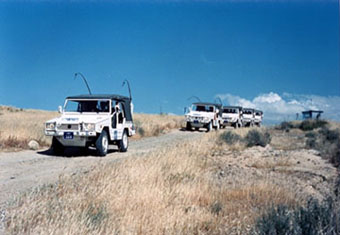Peacekeeping has long been considered Canada's forte. The modern concept of peacekeeping was impelled by the 1956 Suez Crisis when the United Nations Emergency Force (UNEF) was created. Lester B. Pearson, Canada’s Minister of External Affairs at the time, won the Nobel Peace Prize for establishing the force and Canada's reputation for peacekeeping was born. Canada sent the first peacekeepers to Egypt on 24 November 1956.

|
| Spr Ed Leatherwood and Spr Brock Matthews of the Royal Canadian Engineers look for mines near the Suez Canal (courtesy DND). |
What appealed most to Canada in the 1945 UN Charter was the idea of extending the rule of law to the world, providing a framework from which to regulate disputes and restrain violence. In the 1950s, Pearson understood that an independent UN force was needed to enforce a ceasefire during an international crisis while a political settlement was reached. This need had been proven in Korea.
The Charter allowed the UN to conduct military operations. The UN formed an army when the Korean War erupted. Canada contributed to that effort, fighting for the UN, not Korea.
American forces under General MacArthur defeated North Korean troops but did not stop the “police action,” as United States president Harry Truman called the conflict. Canada initially supported the United States’ condemnation of North Korea but soon found it necessary to curb the impetuous Americans to avoid involving Communist China, which could have precipitated a world war.
The UN's pledge to forge “a unified independent and democratic Korea” was overlooked. The UN had a new image as a lackey for the United States. Clearly, the UN needed to be independent of any country's ambitions in an international situation, such as that which arose in Egypt on 26 July 1956.
Egyptian Prime Minister Gamal Abdel Nasser nationalized the Suez Canal when the US and Britain withdrew financial support of the Aswan Dam project because of Egypt's increasing chumminess with Czechoslovakia and the USSR. The Americans were already miffed at Egypt for recognizing Communist China. Britain and France were afraid Nasser would close the canal, stopping petroleum shipments between the Persian Gulf and Western Europe. Nasser declared martial law around the canal.
On 29 October, Israel attacked Egypt. The Egyptians, well-armed but poorly-led, were outmatched. Claiming to want to stop the fighting and keep the canal open, France and Britain also sent troops into Egypt after it rejected their ultimatum to withdraw. Pearson suspected they wanted to overthrow Nasser, who had resisted colonial control of Egypt. In any case, neither country foresaw the international reaction to their hostility.
The UN General Assembly held an emergency session on 1 November and condemned the three aggressors. The Assembly took sides when the US demanded an immediate ceasefire. Pearson knew that support from Canada would be sure to antagonize Britain and France. A ceasefire would be ineffective with no provision to supervise or enforce it. Pearson abstained from the vote, a tactical move to allow more time to finalize his plan.
In his address to the Assembly, Pearson remarked that a ceasefire was not enough. “In six months we’ll go through all this again if we do not take advantage of this crisis... to do something about a political settlement.” He suggested forming a special emergency force to keep peace on the Israeli-Egyptian border pending a settlement.
The resolution for Pearson's plan was passed on 4 November. The United Nations Emergency Force (UNEF), the first peacekeeping force in history, was established, with Canadian General E.L.M. Burns as its commander.
A problem arose during the planning process. The Queen's Own Rifles was the infantry regiment selected. Although the Egyptian government acknowledged Canada's independence, it pointed out that the Canadian uniforms, regimental name and flags were similar to those of the British. To the average Egyptian, the Canadians and British were indistinguishable. The nomination of the regiment was cancelled but Canada did deploy 300 service troops as a replacement in November, followed later by reconnaissance, administrative and support troops. By January 1957 there were over 1,100 Canadian military personnel stationed in Egypt.

|
| A convoy of Canadian soldiers in their light combat Iltis vehicles, patrolling the Green Line near Nicosia (courtesy National Defence). |
In May 1967, Egypt asked UNEF troops to withdraw. In 1973 Canada participated in a second emergency force operation — UNEF II — after the Arab-Israel Yom Kippur War.
The UN initiative did not end war, but it did make big wars less likely. The Suez Crisis was an important event in Canada's relations with Britain. Canada had always automatically responded to imperial requests, but this time made her own stand.

 Share on Facebook
Share on Facebook Share on X
Share on X Share by Email
Share by Email Share on Google Classroom
Share on Google Classroom


